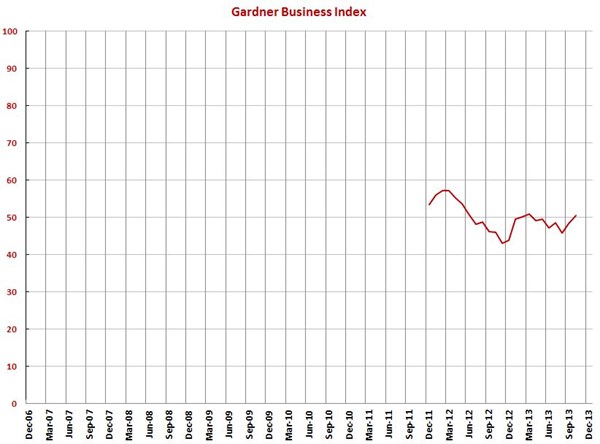October GBI at 50.5 – First Growth in Six Months
The index was 10.0% higher than it was in October 2012. This was the third time in four months that the index was higher than the same month one year ago.
#economics
With a reading of 50.5, the Gardner Business Index shows that durable goods manufacturing grew for the first time since March 2013. October 2013 was just the second month of growth in durable goods manufacturing since June 2012. The index was 10.0% higher than it was in October 2012. This was the third time in four months that the index was higher than the same month one year ago.
New orders grew for the first time since May 2013 and at their fastest rate since March 2013. Production grew for the second month in a row, growing at its fastest rate since June 2012. Because production grew faster than new orders, backlogs continued to contract. However, backlogs contracted at their slowest rate since February 2013. Employment expanded for the second straight month. Exports continue to contract as the dollar has been strengthening relative to other currencies. Supplier deliveries continue to lengthen, but they did so at a slower rate. Material prices increased at a faster rate while prices received by manufacturers were essentially flat. Future business expectations improved significantly, reaching their highest level since May 2012.
Facilities with more than 50 employees grew at a significant rate in October, just as they have for most of 2013. Facilities with fewer than 50 employees still contracted, but they did so at virtually their slowest rate in 2013. Facilities with fewer than 19 employees saw their index rise to 48.1 in October from 40.8 in August.
Pumps, valves, and plumbing products grew at the fastest rate with an index of 58.0. Medical, electronics, automotive, machinery and equipment, and primary metals all had strong growth in October. Also growing were plastics and rubber, custom processors, and petrochemical processors. Aerospace moved to a slight contraction from significant growth. Forming and fabricating is contracting at its fastest rate since December 2012.
The Mountain region grew at the fastest rate, 58.4, in October. This the third time in four months the region has had an index above 54.0. New England also grew for the third time in four months. The South Atlantic, West North Central, and Pacific regions moved to growth from contraction. The other regions, except the East South Central, had just a mild rate of contraction in October.
Planned capital expenditures were up 39.7% compared to October 2012. This was the fastest rate of month-over-month growth since February 2013.
In addition to the overall durable goods index, we compute indices for a number of technologies or processes. After three months of none of the technologies growing, four of the six grew in October. Composites grew the fastest with an index of 51.2. Metalworking, moldmaking, and finishing also had moderate growth. Production machining was essentially flat with an index of 49.9, which was the industry’s highest level since February 2013. Plastics contracted for the third month in a row.
Also, you can find indices for the following end markets: aerospace; automotive; custom processors; electronics, computers and telecommunications; forming and fabricating (non-auto); machinery and equipment manufacturing; medical; metalcutting job shops; petrochemical processors; plastics and rubber; primary metals; and pumps, valves, and plumbing products.


RELATED CONTENT
-
Is The V8 Dead?
Tougher fuel economy standards may be the end of most V8s.
-
On The German Auto Industry
A look at several things that are going on in the German auto industry—from new vehicles to stamping to building electric vehicles.
-
On Quantum Navigation, EVs, Auto Industry Sales and more
Sandia’s quantum navi, three things about EVs, transporting iron ore in an EV during the winter, going underwater in an EV (OK, it is a sub), state of the UK auto industry (sad), why the Big Three likes Big Vehicles, and the future of logistics.


.JPG;width=70;height=70;mode=crop)